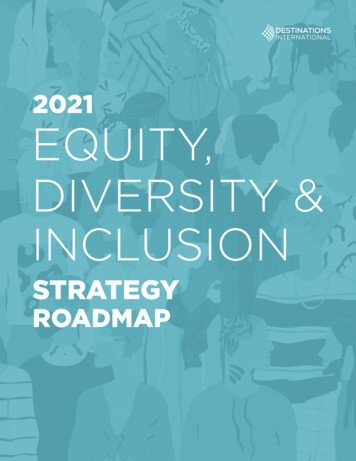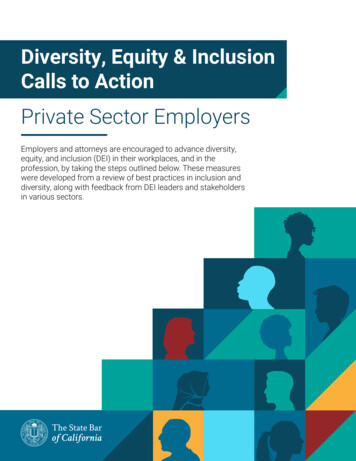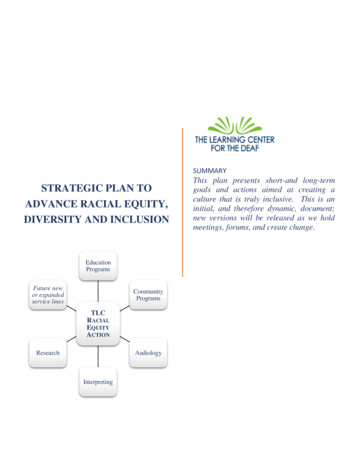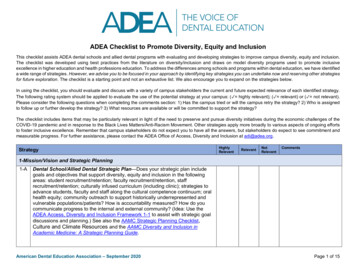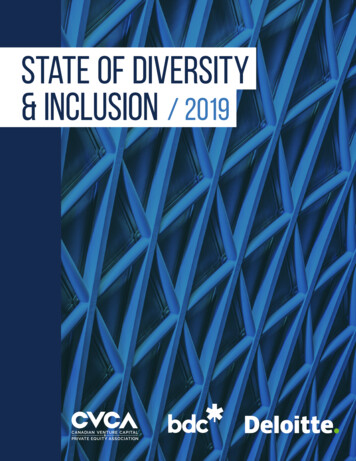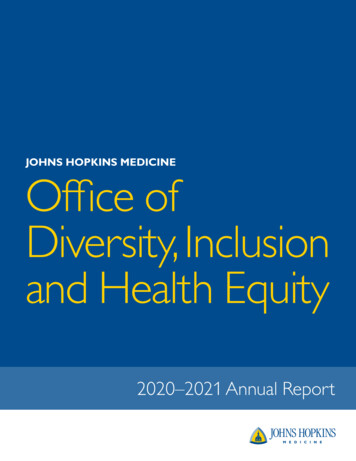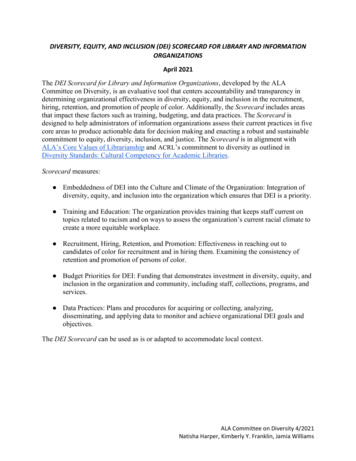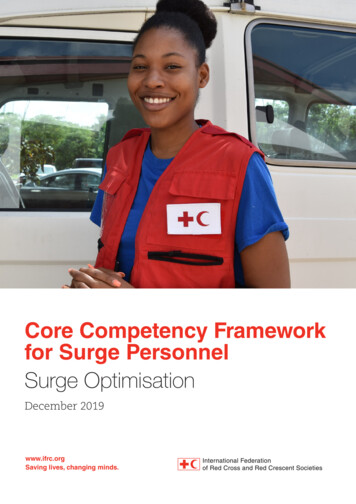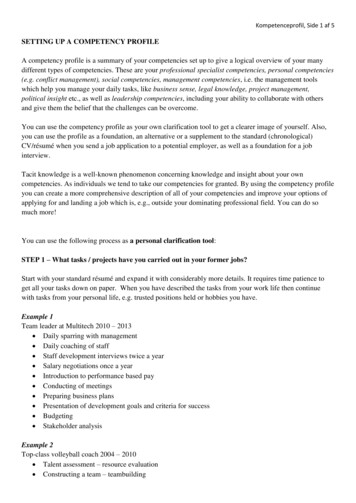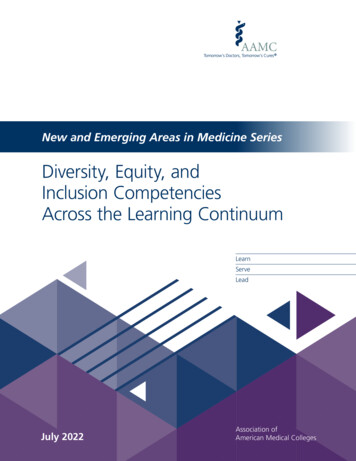
Transcription
New and Emerging Areas in Medicine SeriesDiversity, Equity, andInclusion CompetenciesAcross the Learning ContinuumLearnServeLeadJuly 2022Association ofAmerican Medical Colleges
New and Emerging Areas in Medicine SeriesDiversity, Equity, andInclusion CompetenciesAcross the Learning ContinuumAssociation of American Medical CollegesWashington, D.C.
The AAMC (Association of American Medical Colleges) is a nonprofit association dedicated to improving the health of people everywhere through medicaleducation, health care, medical research, and community collaborations. Its members comprise all 155 accredited U.S. and 16 accredited Canadian medicalschools; approximately 400 teaching hospitals and health systems, including Department of Veterans Affairs medical centers; and more than 70 academicsocieties. Through these institutions and organizations, the AAMC leads and serves America’s medical schools and teaching hospitals and the millionsof individuals employed across academic medicine, including more than 191,000 full-time faculty members, 95,000 medical students, 149,000 residentphysicians, and 60,000 graduate students and postdoctoral researchers in the biomedical sciences. In 2022, the Association of Academic Health Centersand the Association of Academic Health Centers International merged into the AAMC, broadening the AAMC’s U.S. membership and expanding its reachto international academic health centers. Learn more at aamc.org.Suggested citation: AAMC. Diversity, Equity, and Inclusion Competencies Across the Learning Continuum. AAMC New and Emerging Areas in Medicine Series.Washington, DC: AAMC; 2022. 2022 Association of American Medical Colleges. May not be reproduced or distributed without prior written permission. To request permission,please visit aamc.org/91514/reproductions.html.
ContentsPrefaceivAcknowledgmentsvSeries Introduction12Competency-Based EducationHistorical Context of Diversity, Equity,2and Inclusion CompetenciesCross-Continuum Competencies: Diversity,Equity, and Inclusion4Organization of the Competencies5Intended Uses5Caveats5Feedback on the Competencies6Resources and Tools6Diversity, Equity, and Inclusion Competencies7Domain I: Diversity8Domain II: Equity911Domain III: InclusionCurricular Models for Integrating andImproving Diversity, Equity, and Inclusionin Medical Education13Caring for Patients With Intellectualor Developmental Disabilities (IDD):The Introduction of the Standardized14Patient With IDDSexual and Gender Minority Health15Faculty Development ModulesFaculty Development in Antiracist Pedagogyand Critical Consciousness16Biomedical, Behavioral, Social Sciences,and Medical Ethics Curriculum17Appendix A . Development Processand Survey Questions18Development Process19Survey Questions19Appendix B. Glossary of Select Terms21References26iii Diversity, Equity, and Inclusion Competencies Across the Learning ContinuumAAMC.ORG
PrefaceHealth care is changing rapidly. New technologies, advances in care delivery, and scientific discoveries are happening atrates that make it challenging for teaching and learning practices across the continuum to keep up. Whether learners areat the beginning of their career or seasoned clinicians, new demands and advances in health care require them to acquirenew competencies. The AAMC New and Emerging Areas in Medicine Series is a guide for everyone who develops curriculawithin the field of medicine and for people learning to practice or continuing their professional development.“The AAMC New and Emerging Areas in Medicine Series is a guide foreveryone who develops curricula within the field of medicine and forpeople learning to practice or continuing their professional development.”Each set of new and emerging competencies is developed by leaders from across the medical education and clinicalpractice communities, including hundreds of reviewers of iterative drafts who provided input through surveys andfocus groups. These competencies add depth to selected emerging areas to help guide curricular and professionaldevelopment, formative performance assessment, cross-continuum collaborations, and, ultimately, improvements inhealth care services and outcomes. They are not intended for high-stakes assessment or for purposes of accreditation.This series includes competencies in quality improvement and patient safety (QIPS), telehealth, and now, with thisreport, diversity, equity, and inclusion (DEI).iv Diversity, Equity, and Inclusion Competencies Across the Learning ContinuumAAMC.ORG
AcknowledgmentsThe AAMC acknowledges the dedication of the talented members of the Diversity, Equity, and Inclusion AdvisoryCommittee, who helped develop and revise draft competencies, and the hundreds of students, residents, faculty,affiliates, patient advocates, and others who reviewed drafts throughout the iterative development process. We thankthem for their dedication to advancing DEI through education and collaboration across the continuum.DIVERSITY, EQUITY, AND INCLUSION ADVISORY COMMITTEE, 2019-2021Kendall Campbell, MDBeth Nelson, MDSenior Associate Dean for Academic AffairsAssociate Dean of Undergraduate Medical EducationBrody School of Medicine at East Carolina UniversityUniversity of Texas at Austen Dell Medical SchoolCliff Coleman, MD, MPHAnn-Gel Palermo, DrPH, MPHAssociate Professor of Family MedicineAssociate Dean for Diversity and InclusionOregon Health & Science Universityin Biomedical EducationSchool of MedicineIcahn School of Medicine at Mount SinaiChiquita A. Collins, PhDBrenda Pereda, MDChief Diversity Officer, Vice Dean for Inclusion and DiversityAssistant Dean for Diversity, Equity and InclusionUniversity of Texas Health Science Center at San AntonioUniversity of New Mexico School of MedicineJoe R. and Teresa Lozano Long School of MedicineJennifer E. Potter, MDAustyn Holleman, MSW, MPH, LGSWAdvisory Dean and Director of the William B. Castle SocietyManager of Senior Mental Health ProjectBeth Israel Deaconess Medical CenterMary’s Center, Washington, D.C.José E. Rodríguez, MD, FAAFPAletha Maybank, MD, MPHAssociate Vice President for Health Equity and InclusionChief Health Equity OfficerUniversity of Utah HealthAmerican Medical AssociationLawrence K. Rolle, MD, MBAWilliam McDade, MD, PhDCombined Internal Medicine and Pediatrics ResidentChief Diversity and Inclusion OfficerUniversity of Miami, Jackson, Memorial HospitalAccreditation Council for Graduate Medical EducationDavid McIntosh, PhD, MAMedical Student RepresentativeKeck School of Medicine of the University of Southern CaliforniaVice Dean for Justice, Equity, Diversity, and InclusionRichard deShazo, MDUniversity of California, Los Angeles,Emeritus Professor of Medicine and PediatricsDavid Geffen School of MedicineUniversity of Alabama at BirminghamMichelle Morse, MD, MPHMarnix E. Heersink School of MedicineInstructor in Medicine, Co-Founder,Jeffrey Uribe, MDSocial Medicine ConsortiumEmergency Medical Service FellowHarvard Medical SchoolNewark Beth IsraelJann Murray-García, MD, MPHDonald Warne, MD, MPHAssociate Clinical Professor,Associate Dean of Diversity, Equity and InclusionBetty Irene Moore School of NursingUniversity of North Dakota School of MedicineUC Davis Healthand Health Sciencesv Diversity, Equity, and Inclusion Competencies Across the Learning ContinuumAAMC.ORG
AAMC STAFFDavid Acosta, MDNorma Poll-Hunter, PhDSenior Director, Workforce DiversityChief Diversity and Inclusion OfficerTiffani St.CloudExecutive Co-SponsorDirector, Educational InitiativesAdrien BarriosKarey Sutton, PhDProgram Specialist, Strategic Initiatives and PartnershipsFormer Director of Research, AAMC Center for Health JusticeMalika Fair, MD, MPHSenior Director, Equity and Social AccountabilityLisa Howley, PhD, MEdSenior Director, Strategic Initiatives and PartnershipsSeries LeadSherese B. Johnson, MPH, PMPFormer Director, Public Health InitiativesFormer Director, Health Equity Research Work ForceKamilah Weems, MSDirector, Strategic Initiatives and PartnershipsSeries Co-LeadAlison Whelan, MDChief Academic OfficerExecutive Co-SponsorDirector, Diversity, Equity, and InclusionDiana LautenbergerDirector, Gender Equity InitiativesRoss McKinney, MDChief Scientific OfficerExecutive Co-SponsorTitles and affiliations reflect those while people were active on the committee and may not be current.vi Diversity, Equity, and Inclusion Competencies Across the Learning ContinuumAAMC.ORG
Series Introduction
Series IntroductionCOMPETENCY-BASED EDUCATIONCompetency-based education (CBE) is a developingapproach to health professions education. The AAMC hasa long history with CBE and defining the fundamentals forpracticing in an increasingly complex health care system.Over the past 20 years, medical education has improvedin many ways, including in how outcomes such ascompetencies are defined and used to guide teaching andlearning. To support this kind of positive change, we offerthe New and Emerging Areas in Medicine Series. The seriesframes competencies across the undergraduate, graduate,and continuing medical education continuum. This reportincludes an introduction to CBE and competencies indiversity, equity, and inclusion (DEI), including the historicalcontext and importance of developing competence in thisarea and tactics for integrating this essential educationalfocus into the curriculum. Details about the developmentprocess and a glossary of terms are included as appendixes.The origins of these inequities are often rooted in systemicracism and discrimination and are compounded by socialrisk factors that influence health (e.g., low-quality housing,food insecurity, poor access to transportation).10-12 At thenexus of education and clinical care, academic medicinehas a responsibility to address and mitigate the factorsthat drive racism and bias in health care and to preparephysicians who are culturally responsive and trained toaddress these issues.While there has been significant progress in improvingmedical education in the past 20 years, medical schoolsand residency programs approach preparing studentsfor culturally responsive care in variable and siloed ways.This content is often addressed in just one course or as astandalone elective. Some institutions struggle with findingfaculty who can appropriately teach about culturallyresponsive care.More than two decades ago, the Liaison Committee onHISTORICAL CONTEXT OF DIVERSITY, EQUITY,AND INCLUSION COMPETENCIESThe goal of medical education is to prepare physiciansto improve health and evolve as evidence evolves. Sincethe founding of the United States, there have beensystemic health and health care inequities groundedin racism, sexism, homophobia, classism, and otherforms of discrimination that still permeate our currenthealth system. National data reports from the Agencyfor Healthcare Research and Quality and the CentersMedical Education (LCME ) introduced an accreditationstandard for medical schools supporting integrating culturalcompetence into the curriculum. The standard currentlystates that “faculty and students must demonstrate anunderstanding of the manner in which people of diversecultures and belief systems perceive health and illness andrespond to various symptoms, diseases, and treatments.Medical students should learn to recognize and appropriatelyaddress gender and cultural biases in health care delivery,while considering first the health of the patient.” 13for Disease Control and Prevention show that racialIn 2012, the Accreditation Council for Graduate Medicaland ethnic minority groups, people who live in poverty,Education (ACGME) also launched a Clinical Learningrural and urban underserved communities, and LGBTQEnvironment Review (CLER) program as a part of itscommunities disproportionately experience poor healthNext Accreditation System (NAS). This program includesand health care. The current and the next generationshealth care disparities as one of its six focus areas. Also,of physicians need to be prepared to be responsive to thewithin the NAS, individual specialties include a varietypublic health and societal needs of everyone.of milestones (outcomes) related to addressing social1Recent broad societal calls for social justice and thedisparate impacts of the COVID-19 pandemic have addedurgency to the need for improved integration of diversity,equity, inclusion, and anti-racism in medical educationand training. Medical students and residents have alsostrongly expressed the need for curricular change. Thischange is particularly important in light of growingevidence that health care provider biases and behaviorsdeterminants of health, cultural humility, and advocatingfor health equity (acgme.org). More recently, the ACGMEhas established a new initiative, Equity Matters, which aimsto “drive change within graduate medical education (GME)by increasing physician workforce diversity, and buildingsafe and inclusive learning environments, while promotinghealth equity by addressing racial disparities in healthcare and overall population health.” 14can be significant factors in health care disparities.2-92 Diversity, Equity, and Inclusion Competencies Across the Learning ContinuumAAMC.ORG
Series IntroductionThe Accreditation Council for Continuing MedicalIn conjunction with the efforts by local programs and byEducation (ACCME) recently convened a task force toaccrediting and certification bodies, further work is neededunderstand the scope of diversity, equity, and inclusionto align DEI efforts across the continuum and, ultimately,activities in the continuing education community anddevelop physicians who are more fully equipped to addressmake recommendations for further action (accme.org).inequities in health care and who value diversity in all itsThe member boards of the American Board of Medicalforms. These competencies build on existing knowledge,Specialties (ABMS) are addressing DEI in various ways, fromacknowledge current efforts in academic medicine,efforts related to governance to certifying examinationsand provide specific outcomes expected of students,and continuing certification programs (abms.org).residents, and faculty as they continue to grow and learn.3 Diversity, Equity, and Inclusion Competencies Across the Learning ContinuumAAMC.ORG
Cross-Continuum Competencies:Diversity, Equity, and Inclusion
Cross-Continuum Competencies: Diversity, Equity, and InclusionORGANIZATION OF THE COMPETENCIESCAVEATSThese competencies were developed over 24 monthsThese important caveats further clarify the design, intent,through an iterative process with extensive feedback fromand use of the cross-continuum competencies:people engaged in health professions education, faculty Although building competence in DEI is a journey anddevelopment, research, direct patient care, and expertsin DEI. (See Appendix A for details.) The competenciesare organized into three domains — (1) Diversity, (2) Equity,and (3) Inclusion — and three tiers that representdevelopmental stages in physician development: (1) entryto residency or recent medical school graduate, (2) entryto independent practice or recent residency graduate,and (3) experienced faculty physician responsible foreducating students or residents.INTENDED USESThese cross-continuum competencies help educatorsdesign or adapt curricula and help educators andlearners in their individual professional developmentand DEI journeys. The competencies can supplementexisting competencies by providing more detail anddepth and guide DEI curricular and professionaldevelopment, formative performance assessments, andcross-continuum collaborations and, ultimately, improvehealth care services and outcomes. They are not intendedto be used for high-stakes assessments or accreditationof schools, programs, or institutions. Examples ofintended uses include: Engaging health care professionals in collaborativeDEI discussions, including cross-continuum andcross-discipline colleagues. Conducting gap analyses of local curriculaand training programs. Self-assessing and planning individualprofessional development. Developing curricular learning objectives. Developing assessment tools. Furthering research and scholarship in medicalnot a destination, this work aims to provide a standard setof expectations or outcomes along the developmentalcontinuum. New demands and advances in health carerequire all health professionals, whether at the beginningor end of their careers, to be learners and acquire newand refresh existing competencies. These competencies recognize the important impactphysicians have at the individual patient, health careteam, health system, and community levels. And in allcases, the intent is to clarify the role of the physician andwhat they should know, do, and value in relation to theirown practice, their team, and their health care system. Important terms and phrases are defined in theglossary (Appendix B). Competencies related to systems-level changes, advocacy,policy changes, and role modeling may be aspirationalfor some, depending on their local environment,education, and training. As we did with other sets ofcompetencies, we strove to reach consensus in thebalance we struck between what some subject matterexperts may consider below expectation and othersmay consider aspirational. We will continue to listento and learn from our diverse communities as we workon the next iteration. The first set of competencies in this series, QualityImprovement and Patient Safety (QIPS),15 includes adomain titled “health equity in QIPS,” and two relevantcompetencies from that set are included here. We willupdate the full set of QIPS competencies soon to betterreflect the progress made not only in health equity, butin the overall domains of quality and safety. The third tier of competencies is designed for those whoteach or supervise students or residents in a clinicallearning environment, not all physicians.education and DEI. Guiding the strategic integration of DEI into the formalcurricula and the clinical learning environment.5 Diversity, Equity, and Inclusion Competencies Across the Learning ContinuumAAMC.ORG
Cross-Continuum Competencies: Diversity, Equity, and InclusionFEEDBACK ON THE COMPETENCIESRESOURCES AND TOOLSThis work is dynamic, and the competencies shouldThe AAMC has several freely available resources to supportbe considered with that in mind. We plan to reviewteaching and learning the competencies, and we welcomeand regularly update the competencies based onyour contributions to these growing collections:feedback from the community and new evidence and MedEdPORTAL, The Journal of Teaching and Learningevolving language in these domains. Please contactDEICompetencies@aamc.org to share feedback, resources,suggestions, and exemplars for teaching and learning.Resources, Anti-racism in Medicine Collection16 and theDiversity, Inclusion, and Health Equity17 Collection. The Clinical Teaching and Learning Experiencescollection.18 Cultural Competence Education for Students inMedicine and Public Health: Report of an Expert Panel.136 Diversity, Equity, and Inclusion Competencies Across the Learning ContinuumAAMC.ORG
Diversity, Equity, andInclusion Competencies
Diversity, Equity, and Inclusion CompetenciesDOMAIN I: DIVERSITYDiversity “refers to the identities we carry. There are many kinds of diversity, based on race, gender, sexual orientation,class, age, country of origin, education, religion, geography, physical or cognitive abilities, or other characteristics.Valuing diversity means recognizing differences between people, acknowledging that these differences are a valuedasset, and striving for diverse representation as a critical step towards equity.” 19Entering Residency(Recent Medical School Graduate)orNew to DEI JourneyEntering Practice(Recent Residency Graduate)orAdvancing Along DEI JourneyFaculty PhysicianTeaching and LeadingorContinuing DEI JourneyAll prior competencies All prior competencies Advancing Diversity and Integration in PracticeKnowledge and practices demonstrating that one values and understands how aspects of an individual’s overlapping identitiescreate unique lived experiences that may influence health and health care outcomes1a. D emonstrates evidence of self-reflectionand how one’s personal identities,biases, and lived experiences mayinfluence one’s perspectives, clinicaldecision-making, and practice1b. Mitigates the effects of personal bias inclinical decision-making and deliveryof patient care1c. Role models how the practiceof self-reflection can help withidentifying and mitigating effectsof personal biases2a. Demonstrates the value of diversityby incorporating dimensions ofdiversity into the patient’s healthassessment and treatment plan2b. Gathers and applies patient-identifieddemographic data to develop acomprehensive patient healthassessment and treatment plan2c. R ole models and teaches how tocollect and apply patient-identifieddemographic data to develop acomprehensive patient healthassessment and treatment plan3a. D emonstrates knowledge of theintersectionality of a patient’s multipleidentities and how each identity mayresult in varied and multiple formsof oppression or privilege related toclinical decisions and practice3b. Applies knowledge of intersectionalityto inform clinical decisions and practice3c. Role models how knowledge ofintersectionality informs clinicaldecision-making and practiceAdvocating for a Diverse Health Care Team and SystemActions that promote social, economic, educational, and policy changes that advocate for achieving optimal learning, health,and well-being within the health care team and the system84a. A nalyzes policies and practices thatpromote and ensure diversity of thehealth care team4b. Advocates for policies and practicesthat promote, build, and sustaindiversity of the health care team4c. Role models and teaches how toadvocate for policies and practicesthat promote, build, and sustaindiversity of the health care team5a. Identifies the system-level policies,procedures, and practices that mayor may not promote diversity andinclusion in the health care system5b. Adheres to system-level policies,procedures, and practices thatpromote diversity and inclusionin the health care system5c. L eads, advocates for, and/or participatesin the development, implementation,and review of policies, procedures,and practices that promote diversityand inclusion in the health care system Diversity, Equity, and Inclusion Competencies Across the Learning ContinuumAAMC.ORG
Diversity, Equity, and Inclusion CompetenciesDOMAIN II: EQUITYEquity “refers to fairness and justice and is distinguished from equality. While equality means providing the same to all,equity requires recognizing that we do not all start from the same place because power is unevenly distributed. The processis ongoing, requiring us to identify and overcome uneven distribution of power as well as intentional and unintentionalbarriers arising from bias or structural root causes.” 19Entering Residency(Recent Medical School Graduate)orNew to DEI JourneyEntering Practice(Recent Residency Graduate)orAdvancing Along DEI JourneyFaculty PhysicianTeaching and LeadingorContinuing DEI JourneyAll prior competencies All prior competencies Mitigating Stigma and Implicit and Explicit BiasesPractices that mitigate implicit and explicit attitudes or stereotypes in favor of or against one person or group compared with another;biases may influence attitudes and behaviors adversely, leading to discriminatory practices, especially when clinicians and educatorsare faced with external pressure or limited time1a. Articulates how one’s own identities,power, and privileges (e.g., professionalhierarchy, culture, class, gender)influence interactions with patients,families, communities, and membersof the health care team1b. Seeks and acts upon feedback abouthow one’s own identities, power, andprivileges influence patients, families,communities, and members of thehealth care team1c. Role models and teaches how toengage in reflective practices relatedto individual identities, power, andprivileges to improve interactions withpatients, families, communities, andmembers of the health care team2a. Demonstrates knowledge aboutthe role of explicit and implicit biasin delivery of high-quality care1,22b. Identifies and mitigates explicit andimplicit biases that occur in clinicaldecision-making1,22c. Role models effective strategies tomitigate explicit and implicit biasesthat may negatively affect clinicaldecision-making1,2Eliminating Inequities in Health CarePractices that measurably reduce population-level differences in health outcomes, disease burden, and the distribution or allocationof resources between majority and marginalized groups based on race, ethnicity, sex, sexual orientation, gender identity, intellectualand developmental ability, socioeconomic status, the physical (built) environment, geographic location, and psychosocial-, behavioral-,and health care-related factors3a. D escribes the value of working inan interprofessional team, includingpatients, to identify and addresssocial risk factors influencing health(e.g., food security, housing, utilities,transportation)3b. W orks collaboratively with aninterprofessional team, includingpatients, to screen and refer patientsfor appropriate resources to addresssocial determinants of health3c. Role models collaborative practicesfor working with an interprofessionalteam to address social determinantsof health affecting patientsand communities4a. Identifies systems of power, privilege,and oppression and their impacts onhealth outcomes (e.g., White privilege,racism, sexism, heterosexism, ableism,religious oppression)4b. M akes collaborative care decisionsbased on an understanding of howsystems of power, privilege, andoppression influence health carepolicies and patient health outcomes4c. T eaches how systems of power,privilege, and oppression informpolicies and practices and how toengage with systems to disruptoppressive practices(continued)9 Diversity, Equity, and Inclusion Competencies Across the Learning ContinuumAAMC.ORG
Diversity, Equity, and Inclusion Competencies(continued)5a. D escribes how stratification(e.g., by race, ethnicity, primarylanguage, socioeconomic status,LGBTQ identification) of qualitymeasures can allow identificationof health care disparities15b. E xplores stratified qualityimprovement (QI) data for theirpatient population and uses thesedata to identify health care disparities15c. Describes how monitoring stratifiedQI data can help assess the riskof unintended consequences(e.g., widening the disparity gap)and uses stratified QI data to guideand monitor QI interventions16a. Explains the role of the health caresystem in identifying and meetingthe local needs of the community(e.g., the role of the communityhealth needs assessment or thecommunity health improvement plan)6b. C ollaborates with a diverseinterprofessional team withintheir system and with communitymembers to meet identifiedcommunity health needs6c. Leads, formulates, and/or participatesin interprofessional partnershipsdesigned to improve communityhealth needsPracticing Anti-racism and Critical Consciousness in Health CareEducational and clinical practices that seek to revise and correct local, state, and national policies; institutional practices; and culturalmisrepresentations that enable and perpetuate racial bias and race-based health care inequities7a. D escribes past and current examples ofracism and oppression (internalized,interpersonal, institutional, andstructural) and their impact on trust,health, and health care7b. Engages with the health careteam and patients to identify theimpacts of racism and oppressionand challenges these behaviors andpractices in the local setting7c. Role models anti-racism in medicineand teaching, including strategiesgrounded in critical understanding ofunjust systems of oppression8a. Articulates race as a social constructthat is a cause of health and health careinequities, not a risk factor for disease8b. I dentifies and corrects misuse ofclinical tools and practices thatsubstantiate race-based medicine8c. S upports and participates insystem-level solutions to endracist practices in education andclinical delivery that substantiaterace-based medicine9a. D escribes the impact of varioussystems of oppression on health andhealth care (e.g., colonization, Whitesupremacy, acculturation, assimilation)9b. Collaborates to identify and act onsystem-level strategies to reducethe effects of various systems ofoppression on health and health care9c. Teaches and examines system-levelstrategies to remedy the impactof systems of oppression on healthand health careAdvocating for Equity in Health and Health CarePractices that influence decision-makers and other vested groups and individuals to support or implement system-level policiesand practices that contribute to realizing health equity10a. Describes public policy that promotessocial justice and addresses socialdeterminants of health10b. P romotes social justice andengages in efforts to eliminatehealth care disparities10c. Leads or participates in organizationaland public policy approaches topromote social justice, eliminatehealth care disparities, and addresssocial determinants of health(continued)10 Diversity, Equity, and Inclusion Competencies Across the Learning ContinuumAAMC.ORG
Diversity, Equity, and Inclusion Competencies(continued)11a. Identifies and, if appropriate, referspatients to relevant communityresources that promote health equityand improve the health of localcommunities and populations11b. U ses resources that supportpopulation health improvementstrategies (e.g., systems andpolicy advocacy, program andpolicy development, othercommunity-based interventions)11c. Leads, participates in, or supportsinterprofessional partnershipswith local health departmen
Assistant Dean for Diversity, Equity and Inclusion. University of New Mexico School of Medicine. Jennifer E. Potter, MD . Advisory Dean and Director of the William B. Castle Society. Beth Israel Deaconess Medical Center José E. Rodríguez, MD, FAAFP . Associate Vice President for Health Equity and Inclusion. University of Utah Health Lawrence .

